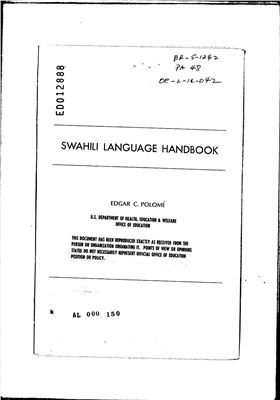USA, U.S. Department of Health, Education & Welfare, 1967. 245
p.
This introduction to the structure and background of the Swahili language was written for the non-specialist. Although the linguistic terminology used in the description of the language assumes the reader has had some training in linguistics, this handbook provides basic linguistic and sociolinguistic information for students of African culture and intermediate or advanced Swahili language students as well as for linguists. In an introduction to the present language situation, this handbook explains the distribution and use of Swahili as a lingua franca, as a pidgin, and as a mother language and explains present usage through a brief history of the language. Dialects of Swahili are discussed and related languages mentioned when relevant to Swahili structure. Although the author places greatest emphasis on the structure of the language (phonology, morphology, derivation, inflection, complex structures, syntax, and vocabulary), he includes chapters on the writing system and Swahili literature. Of special interest to language teachers is a chapter examining specific points of contrast between Swahili and English.
This introduction to the structure and background of the Swahili language was written for the non-specialist. Although the linguistic terminology used in the description of the language assumes the reader has had some training in linguistics, this handbook provides basic linguistic and sociolinguistic information for students of African culture and intermediate or advanced Swahili language students as well as for linguists. In an introduction to the present language situation, this handbook explains the distribution and use of Swahili as a lingua franca, as a pidgin, and as a mother language and explains present usage through a brief history of the language. Dialects of Swahili are discussed and related languages mentioned when relevant to Swahili structure. Although the author places greatest emphasis on the structure of the language (phonology, morphology, derivation, inflection, complex structures, syntax, and vocabulary), he includes chapters on the writing system and Swahili literature. Of special interest to language teachers is a chapter examining specific points of contrast between Swahili and English.

